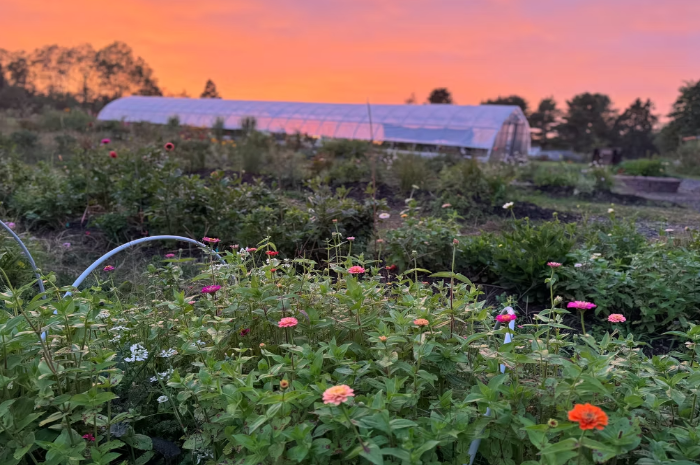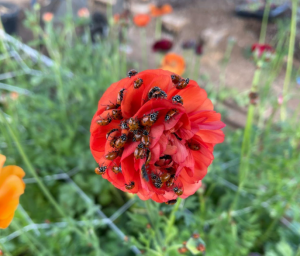Jessica Miller started the Veteran Farm Project (near Windsor, Nova Scotia) when she retired from the Canadian Armed Forces. “My husband and I purchased this farm … not knowing what we were going to do with it,” she said.
The goal of the farm soon became clear: to support female veterans and other women with volunteer opportunities on the farm and to improve food security for local communities struggling to access healthy food.
The farm started by offering produce to local legions to distribute to people in the community.
They now support 50 families experiencing food insecurity. “The demand has increased dramatically,” she said. “We’ve had to pivot in different directions to make sure we meet those obligations.”
Climate change is impacting the Veteran Farm Project
Climate change is one of the reasons the farm has had to pivot. While families depend on the farm to put healthy food on the table, changing growing conditions have started to make it difficult to meet demand. “There’s a lot we used to grow that we can’t, due to the climate impacts.” Warmer and drier conditions mean heat stress for some crops and more demand for water.
Meanwhile, extreme weather has affected farm infrastructure. In 2023, high winds from a hurricane and a set of unusual December storms destroyed much of the farm’s infrastructure, including the two greenhouses.
Miller said pests are also a problem. Warmer winters mean pests aren’t dying off in the winter the way they once did. Pests like Colorado potato beetle and squash bugs have made some crops difficult to grow.
How the Veteran Farm Project is adapting to climate change
To cope with climate change, Miller said the farm has had to adapt, rather than hanging on to its old practices.
“If you’re going to keep fighting nature, you’re going to keep banging your head against the wall.”
Changing growing practices
The Veteran Farm Project has shifted its focus to producing fewer crops that are easy to grow. “One of the big [changes] was eliminating anything that we can’t grow successfully without having to stay on top of it. 24/7, [or use] pesticides.”
This meant cutting out vegetables like cucumbers, which are attacked by pests that thrive in dry conditions. They also moved away from carrots, which have fared poorly in extremely wet conditions. “We’re down to maybe five vegetables that we grow only because we can’t keep up with the major issues that are plaguing us.”
Managing Water
The farm captures the water coming off the farm’s barn, directing water into rain barrels or the well for use in dry periods. “Without harvesting [rain] off the barn, we’d constantly be needing to bring in water.”
Meanwhile, with rain coming in greater volumes when it does fall — a warmer atmosphere holds more moisture, leading to heavier rains — the farm has had to adapt to manage excess water, too. Miller said they’ve installed berms on the slope above the growing field to redirect water. It’s not a common sight, but they’ve also installed a sump pump to help cope with rain that falls faster than the ground can absorb.
Climate impacts on local farmers and food security
Stephanie Arnold, CLIMAtlantic’s Strategy and Innovation Manager, said farmers in the region are now dealing with multiple climate impacts simultaneously. Like Jessica, some farmers are now dealing with drought and extreme precipitation in the same season on top of wind and pests. “It’s adding a lot more complexity and work and preparation onto farmers.”
They’re also impacted by the effects of climate change elsewhere. Climate disruptions worldwide affect supply chains that can make it harder for farmers to access the materials they need, such as fertilizer.
When farmers experience climate disruptions, this impacts food production and increases the costs for consumers. Even if local growers adapt, Arnold said, climate change still poses a threat to food security. “Because the food web and the supply chain is so wide … even if we did a really good job locally in adaptation, if other food producing areas have failed, that impacts food security here.”
Still, improving soil health and changing the kinds of crops farmers are growing can make food production more resilient.
Future considerations for the Veteran Farm Project
Additional adaptations the Veteran Farm Project is considering are a second greenhouse to increase vegetable production. Going forward, they’re also considering further measures like installing solar panels on the roof of the farm’s barn.
For growers trying to make their own contribution to reducing food insecurity in a changing climate, Miller recommends carefully considering the land you’re working with and planning ahead for shifting conditions. “Don’t take for granted that you can put anything in the ground anymore and just grow it,” she said. “You really have to know your space.”
Ultimately, farmers can’t do it alone. It will be important to support farmers to adapt. “Investing in infrastructure to support agriculture is also investing in infrastructure that supports rural communities,” said Arnold. “It’s really going to support rural success, community well-being, livelihoods being generated, and that’s where the excitement that I have in adaptation for agriculture [comes in].”
Additional Resources:
- Nova Scotia Government Climate Change Resources: https://climatechange.novascotia.ca/
- CLIMAtlantic: https://climatlantic.ca/
- Nova Scotia Climate Smart Farming: https://climatesmart.perennia.ca/
Funding support provided by:









